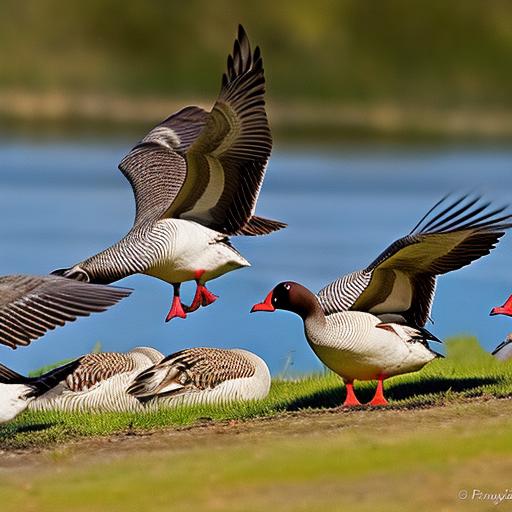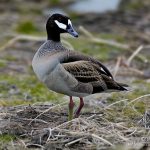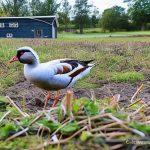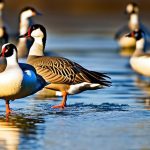Geese are a common sight in outdoor spaces such as parks, golf courses, and lakes. While they can be beautiful to watch, they can also pose challenges for property owners and visitors. Geese are known for their aggressive behavior, especially during nesting season, and their droppings can create unsightly and unsanitary conditions. Fortunately, there are several methods available to deter geese and encourage them to find alternative habitats.
Key Takeaways
- Mean geese can be aggressive and territorial, especially during nesting season.
- Physical barriers like fences and netting can prevent geese from accessing certain areas.
- Sound deterrents like loud noises or predator calls can scare geese away.
- Visual deterrents like decoys or reflective tape can make geese feel uncomfortable and avoid an area.
- Establishing designated feeding areas can discourage geese from wandering and causing damage.
Understanding the behavior of mean geese
Geese can become aggressive for a variety of reasons. One of the main reasons is when they feel threatened or perceive a potential threat to their nests or goslings. Geese are highly protective of their young and will not hesitate to defend them. They may also become aggressive if they feel cornered or if they have been fed by humans in the past, as they associate humans with food.
Recognizing signs of aggression in geese is important for personal safety. Aggressive geese may hiss, flap their wings, lower their heads, or charge at perceived threats. It is important to give geese a wide berth and avoid approaching them too closely. If you encounter an aggressive goose, it is best to slowly back away and give it space.
Creating physical barriers to deter geese
Physical barriers can be an effective way to deter geese from entering certain areas. Fencing is one common method used to keep geese out of specific areas. The fence should be at least three feet high and have small openings to prevent geese from squeezing through. Another option is to install netting over bodies of water to prevent geese from landing and swimming.
When installing physical barriers, it is important to ensure that they are properly maintained. Regularly inspect fences for any damage or gaps that may allow geese to enter. Repair any damage promptly to maintain the effectiveness of the barrier. Additionally, regularly clean and maintain netting to prevent it from becoming clogged with debris.
Implementing sound deterrents for geese
Sound deterrents can be an effective way to discourage geese from settling in an area. There are several types of sound deterrents available, including sonic devices and predator calls. Sonic devices emit loud noises that mimic the distress calls of geese, which can deter them from the area. Predator calls, such as those of hawks or falcons, can also be effective in scaring off geese.
When using sound deterrents, it is important to use them strategically and vary the sounds to prevent geese from becoming accustomed to them. Place the devices in areas where geese are known to congregate, such as near bodies of water or feeding areas. It is also important to regularly check and maintain the devices to ensure they are functioning properly.
Utilizing visual deterrents to keep geese away
Visual deterrents can be used in conjunction with sound deterrents to further discourage geese from settling in an area. Visual deterrents take advantage of geese’s natural instincts and fear of predators. One common visual deterrent is the use of decoy predators, such as plastic owls or coyotes. These decoys can be placed in areas where geese are known to congregate.
Another visual deterrent is the use of reflective objects, such as shiny tape or balloons. These objects create movement and reflections that can startle and deter geese. It is important to regularly move and rearrange visual deterrents to prevent geese from becoming accustomed to them.
Establishing designated feeding areas for geese
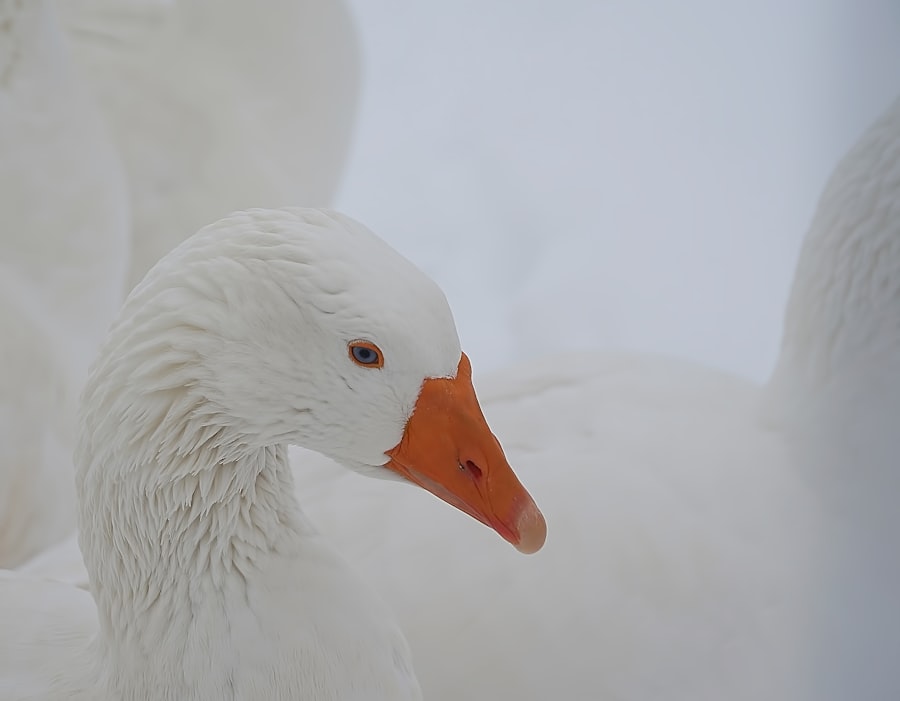
Establishing designated feeding areas for geese can help redirect their behavior and reduce their presence in unwanted areas. By providing a specific area for feeding, property owners can control where geese congregate and minimize their impact on other areas.
When setting up designated feeding areas, it is important to choose a location away from high-traffic areas and water sources. This will help prevent geese from becoming too comfortable in those areas. Additionally, it is important to regularly clean and maintain the feeding area to prevent the buildup of droppings and other waste.
Using natural repellents to discourage geese
Natural repellents can be an effective and environmentally friendly way to discourage geese from settling in an area. There are several types of natural repellents available, including grape extract, garlic oil, and predator urine. These repellents create odors that geese find unpleasant and can deter them from the area.
When using natural repellents, it is important to follow the instructions provided by the manufacturer. Apply the repellent in areas where geese are known to congregate, such as near bodies of water or feeding areas. It is also important to reapply the repellent regularly, especially after rain or heavy watering.
Installing motion-activated devices to scare off geese
Motion-activated devices can be an effective way to scare off geese when they enter a specific area. These devices use sensors to detect movement and emit a loud noise or spray of water when triggered. The sudden noise or spray can startle geese and encourage them to leave the area.
When installing motion-activated devices, it is important to place them strategically in areas where geese are known to congregate. Regularly check and maintain the devices to ensure they are functioning properly. It is also important to vary the location of the devices periodically to prevent geese from becoming accustomed to them.
Maintaining a clean and tidy outdoor environment
Maintaining a clean and tidy outdoor environment is essential for deterring geese. Geese are attracted to areas with abundant food sources, so it is important to remove any spilled food or garbage that may attract them. Regularly clean up droppings and other waste to prevent the buildup of odors and unsightly conditions.
Additionally, it is important to regularly inspect and maintain outdoor spaces to prevent the accumulation of standing water. Geese are attracted to bodies of water for nesting and feeding, so it is important to remove any sources of standing water that may attract them.
Seeking professional help for geese control
In some cases, professional help may be necessary to effectively deter geese from an area. Professional geese control services have the knowledge and experience to implement effective deterrent methods and manage geese populations. They can assess the specific needs of a property and develop a customized plan for geese control.
When seeking professional help, it is important to research and choose a reputable geese control service. Look for companies that have experience working with geese and have positive reviews from previous clients. It is also important to communicate openly with the service provider and provide them with any relevant information about the property.
Educating others on how to coexist with geese peacefully
Educating others on how to coexist with geese peacefully is an important step in managing geese populations. By raising awareness about geese behavior and deterrent methods, property owners and visitors can work together to create a harmonious environment for both humans and geese.
One way to educate others is by providing informational materials, such as brochures or signs, that explain geese behavior and deterrent methods. These materials can be placed in high-traffic areas or near bodies of water where geese are known to congregate. It is also important to lead by example and follow deterrent methods consistently.
In conclusion, there are several methods available for deterring geese from outdoor spaces. By understanding the behavior of mean geese and implementing physical barriers, sound deterrents, visual deterrents, designated feeding areas, natural repellents, motion-activated devices, and maintaining a clean and tidy outdoor environment, property owners can peacefully coexist with geese. In some cases, professional help may be necessary, and educating others on geese behavior and deterrent methods is important for long-term success. By taking action to deter geese, we can create outdoor spaces that are enjoyable for everyone.
If you’re looking for ways to protect your chickens from mean geese, you might find this article on Poultry Wizard helpful. It provides valuable insights on how to design a secure chicken coop that keeps geese away. From choosing the right fencing materials to implementing effective deterrents, this article offers practical tips to ensure the safety and well-being of your feathered friends. Check it out here: https://poultrywizard.com/keeping-chickens/chicken-coop-10/.
FAQs
What are some natural ways to keep mean geese away?
Some natural ways to keep mean geese away include using visual deterrents like scarecrows or reflective objects, planting tall grasses or shrubs to obstruct their view, and using noise deterrents like wind chimes or radios.
Are there any commercial products available to deter mean geese?
Yes, there are commercial products available to deter mean geese such as goose repellent sprays, motion-activated sprinklers, and decoys of natural predators like coyotes or dogs.
How can I prevent mean geese from nesting on my property?
To prevent mean geese from nesting on your property, you can install barriers like fences or netting to block off potential nesting sites, regularly remove any eggs or nests that are found, and use visual or noise deterrents to discourage them from settling in.
Is it legal to harm or kill mean geese to keep them away?
In many places, it is illegal to harm or kill mean geese as they are protected under wildlife conservation laws. It is important to explore non-lethal methods of deterrence and to consult with local authorities or wildlife experts for guidance on dealing with mean geese issues.
Meet Walter, the feathered-friend fanatic of Florida! Nestled in the sunshine state, Walter struts through life with his feathered companions, clucking his way to happiness. With a coop that’s fancier than a five-star hotel, he’s the Don Juan of the chicken world. When he’s not teaching his hens to do the cha-cha, you’ll find him in a heated debate with his prized rooster, Sir Clucks-a-Lot. Walter’s poultry passion is no yolk; he’s the sunny-side-up guy you never knew you needed in your flock of friends!

